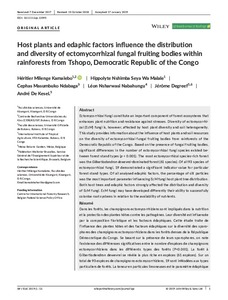| dc.contributor.author | Kamalebo, H.M. |
| dc.contributor.author | Wa Malale, H.N.S. |
| dc.contributor.author | Ndabaga, C.M. |
| dc.contributor.author | Nabahungu, L.N. |
| dc.contributor.author | Degreef, J. |
| dc.contributor.author | De KeseL, A. |
| dc.date.accessioned | 2020-08-03T13:33:01Z |
| dc.date.available | 2020-08-03T13:33:01Z |
| dc.date.issued | 2019 |
| dc.identifier.citation | Kamalebo, H.M., Wa Malale, H.N.S., Ndabaga, C.M., Nabahungu, L.N., Degreef, J. & De KeseL, A. (2019). Host plants and edaphic factors influence the distribution and diversity of ectomycorrhizal fungal fruiting bodies within rainforests from Tshopo, Democratic Republic of the Congo. African Journal of Ecology, 57(2), 247-259. |
| dc.identifier.issn | 0141-6707 |
| dc.identifier.uri | https://hdl.handle.net/20.500.12478/6904 |
| dc.description.abstract | Ectomycorrhizal fungi constitute an important component of forest ecosystems that enhances plant nutrition and resistance against stresses. Diversity of ectomycorrhizal (EcM) fungi is, however, affected by host plant diversity and soil heterogeneity. This study provides information about the influence of host plants and soil resources on the diversity of ectomycorrhizal fungal fruiting bodies from rainforests of the Democratic Republic of the Congo. Based on the presence of fungal fruiting bodies, significant differences in the number of ectomycorrhizal fungi species existed between forest stand types (p < 0.001). The most ectomycorrhizal species‐rich forest was the Gilbertiodendron dewevrei‐dominated forest (61 species). Of all 93 species of ectomycorrhizal fungi, 19 demonstrated a significant indicator value for particular forest stand types. Of all analysed edaphic factors, the percentage of silt particles was the most important parameter influencing EcM fungi host plant tree distribution. Both host trees and edaphic factors strongly affected the distribution and diversity of EcM fungi. EcM fungi may have developed differently their ability to successfully colonise root systems in relation to the availability of nutrients. |
| dc.description.sponsorship | Belgian Federal Science Policy Office |
| dc.format.extent | 247-259 |
| dc.language.iso | en |
| dc.subject | Ectomycorrhizae |
| dc.subject | Fungi |
| dc.subject | Indicators |
| dc.subject | Species |
| dc.subject | Rain Forests |
| dc.subject | Soil Texture |
| dc.subject | Host Plants |
| dc.subject | Soil Resources |
| dc.subject | Edaphic factors |
| dc.subject | Environmental Factors |
| dc.title | Host plants and edaphic factors influence the distribution and diversity of ectomycorrhizal fungal fruiting bodies within rainforests from Tshopo, Democratic Republic of the Congo |
| dc.type | Journal Article |
| cg.contributor.crp | Roots, Tubers and Bananas |
| cg.contributor.affiliation | University of Kisangani |
| cg.contributor.affiliation | Centre de Recherches Universitaires du Kivu |
| cg.contributor.affiliation | Université Officielle de Bukavu |
| cg.contributor.affiliation | International Institute of Tropical Agriculture |
| cg.contributor.affiliation | Meise Botanic Garden, Belgique |
| cg.contributor.affiliation | Service Général de l’Enseignement Supérieur et de la Recherche Scientifique, Belgium |
| cg.coverage.region | Africa |
| cg.coverage.region | Central Africa |
| cg.coverage.country | Democratic Republic of the Congo |
| cg.coverage.hub | Central Africa Hub |
| cg.researchtheme | Natural Resource Management |
| cg.identifier.bibtexciteid | KAMALEBO:2019 |
| cg.isijournal | ISI Journal |
| cg.authorship.types | CGIAR and developing country institute |
| cg.iitasubject | Disease Control |
| cg.iitasubject | Forestry |
| cg.iitasubject | Natural Resource Management |
| cg.iitasubject | Plant Ecology |
| cg.iitasubject | Plant Health |
| cg.journal | African Journal of Ecology |
| cg.notes | Published online: 26 April 2019 |
| cg.accessibilitystatus | Limited Access |
| cg.reviewstatus | Peer Review |
| cg.usagerightslicense | Copyrighted; all rights reserved |
| cg.targetaudience | Scientists |
| cg.identifier.doi | https://dx.doi.org/10.1111/aje.12595 |
| cg.iitaauthor.identifier | Nsharwasi Nabahungu: 0000-0002-2104-3777 |

